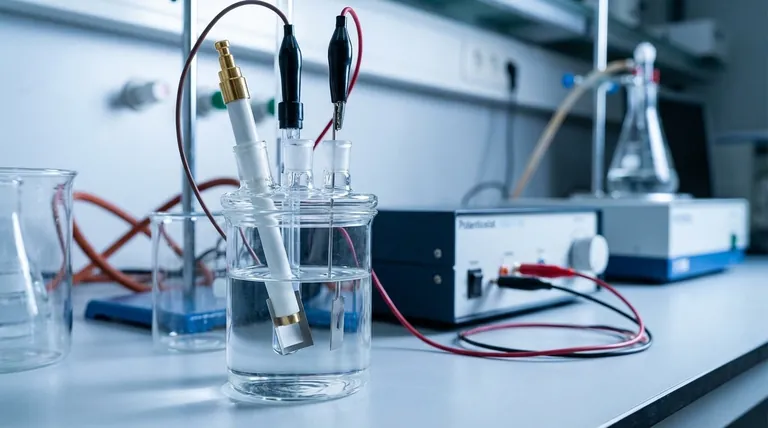To properly operate a platinum sheet electrode, you must first ensure it is physically secure and clean before immersing it fully into a non-corrosive electrolyte. Once submerged, you connect it as the working electrode to a potentiostat to precisely control its electrical potential relative to a reference electrode. The experiment is then run under controlled conditions, often including stable temperature, while you record the resulting electrochemical data.
The goal is not simply to follow procedural steps, but to maintain the absolute chemical purity and electrochemical stability of the platinum surface. Every step—from cleaning to potential control—is designed to ensure your measurements are accurate, reproducible, and reflect the reaction you intend to study, not an artifact of contamination or improper setup.

Foundational Setup: Ensuring a Clean Start
Before any current flows, the validity of your experiment is determined by your setup. A pristine and stable environment is non-negotiable for obtaining meaningful data.
Proper Physical Installation
Secure the electrode in your electrochemical cell using a holder. Ensure the holder is stable and does not exert mechanical stress on the electrode weld points.
Crucially, only the platinum sheet itself should be immersed in the electrolyte solution. Submerging the connecting wire or holder components can introduce metallic impurities and create unwanted side reactions.
Selecting the Right Electrolyte
Platinum is known for its chemical inertness, but it is not invincible. Your choice of electrolyte is critical. Most experiments use aqueous solutions with supporting salts (like KCl or Na₂SO₄) or non-aqueous solvents with salts like TBAPF₆.
Avoid conditions known to attack platinum, such as aqua regia or solutions with high concentrations of halides (like chloride) at highly positive potentials, which can cause oxidative corrosion.
The Critical Role of Electrode Cleaning
The references omit the single most important preparatory step: cleaning. A platinum surface will adsorb impurities from the air or previous experiments within minutes, rendering it useless for reproducible measurements.
Before each experiment, the electrode must be cleaned. Common methods include electrochemical cycling in dilute sulfuric acid (e.g., 0.5 M H₂SO₄) or flame annealing the platinum sheet with a torch until it glows orange-red, followed by cooling in a clean environment.
Controlling the Experimental Parameters
With a clean electrode in a suitable electrolyte, you can now establish precise control over the electrochemical conditions. This is where the actual measurement begins.
Applying Potential with a Potentiostat
A platinum sheet is almost always used as a working electrode in a three-electrode system. You must use a potentiostat or electrochemical workstation for control.
The potentiostat maintains a precise potential difference between your platinum working electrode and a stable reference electrode (e.g., Ag/AgCl or SCE). This controlled potential drives the electrochemical reaction of interest while the current is measured between the working electrode and a counter electrode.
Managing Temperature
Electrochemical reaction rates are highly sensitive to temperature. For reproducible results, you must maintain a constant temperature, typically using a water bath circulator connected to a jacketed cell.
While many experiments are run at room temperature, if your procedure requires a specific temperature, ensure it remains stable throughout the measurement. Fluctuations of even one or two degrees can significantly alter your results.
Understanding the Trade-offs and Common Pitfalls
Even with a perfect setup, challenges can arise during the experiment. Recognizing them is key to interpreting your data correctly.
Surface Contamination
The primary enemy of good electrochemistry is contamination. Trace impurities in your electrolyte, dissolved gases (like oxygen), or residue from improper cleaning can adsorb onto the platinum surface. This blocks active sites and introduces unwanted signals.
Electrode Fouling
During some reactions, especially in organic electrochemistry or electrosynthesis, the products themselves can be insoluble or polymeric. These products can adhere to the electrode surface, a process called fouling or passivation, which deactivates the electrode and stops the reaction.
Potential Window Limitations
Every electrolyte has a potential window—a range of voltages where it is stable. If you apply a potential that is too positive or too negative, you will begin to electrolyze the solvent (e.g., splitting water into H₂ and O₂) or the supporting salt. This will overwhelm the signal from your intended reaction.
Making the Right Choice for Your Goal
Your experimental goal dictates which operational details are most critical.
- If your primary focus is quantitative analysis (e.g., sensing): Meticulous cleaning and maintaining a constant, known immersion depth are paramount for a consistent surface area and response.
- If your primary focus is electrosynthesis: You must ensure your electrolyte is stable at the required potential and actively monitor for signs of electrode fouling by your product.
- If your primary focus is fundamental studies (e.g., cyclic voltammetry): Achieving a textbook-perfect, reproducible starting surface through rigorous cleaning cycles is the most critical factor for success.
Mastering the principles of surface integrity and environmental control is the key to unlocking reliable and insightful electrochemical results.
Summary Table:
| Key Operational Step | Purpose | Critical Consideration |
|---|---|---|
| Cleaning | Remove surface contaminants for a pristine surface. | Use electrochemical cycling or flame annealing before every experiment. |
| Physical Setup | Secure the electrode and isolate the active surface. | Immerse only the platinum sheet; avoid submerging wires or holder. |
| Electrolyte Selection | Provide a stable medium for the reaction. | Avoid corrosive conditions (e.g., high halides at positive potentials). |
| Potential Control | Precisely drive the reaction of interest. | Use a potentiostat in a three-electrode system with a stable reference. |
| Temperature Management | Maintain consistent reaction kinetics. | Use a water bath for temperature control to prevent data fluctuations. |
Achieve precise and reliable electrochemical measurements with confidence. The principles of surface integrity and environmental control are fundamental to your lab's success. KINTEK specializes in high-quality lab equipment and consumables, including electrodes and potentiostats, to support your laboratory's specific needs. Contact our experts today to discuss how we can help you optimize your electrochemical setup and ensure reproducible results.
Visual Guide

Related Products
- Platinum Sheet Electrode for Laboratory and Industrial Applications
- Rotating Platinum Disk Electrode for Electrochemical Applications
- Platinum Auxiliary Electrode for Laboratory Use
- Gold Electrochemical Sheet Electrode Gold Electrode
- Gold Disc Electrode
People Also Ask
- What is the most critical guideline for immersing a platinum sheet electrode in an electrolyte? Ensure Accurate Electrochemical Measurements
- What are the available specifications for platinum sheet electrodes? Find the Perfect Fit for Your Electrochemical Needs
- What precautions should be taken when using a platinum sheet electrode? Ensure Accurate & Reproducible Electrochemical Data
- What is the expected lifespan of a platinum sheet electrode? Maximize Your Electrode's Service Life
- What is the proper post-treatment procedure for a platinum sheet electrode? Ensure Long-Term Accuracy & Protect Your Investment



















